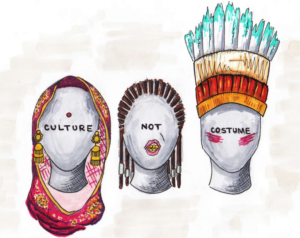WEST LONG BRANCH, N.J. – ‘Tis the season for festivals, and with that comes cultural appropriation galore for celebs and plebs worldwide. For those who don’t know, cultural appropriation is defined as the act of taking or using things from a culture that is not your own, especially without showing that you understand or respect this culture. In the wise words of Dr. Jane Foster, the lady love of Thor, “By appropriate do you mean steal?”
Being an Indian who still practices Hinduism in America has become very trying during this time. For years, I was made fun of for the very things that are now being sold in stores as organic lotions, like coconut oil, which Indian woman have used in their hair for centuries. And forget wearing a bindi to school by accident; I kid you not, the one time that I did that, a classmate of mine called my jeweled religious symbol a pimple. According to a priest at a local Hindu temple, the bindi is associated with the third eye in the Hindu religion and the red dot between the eyebrows is said to retain energy in the human body and control the various levels of concentration. It is also the central point of the base of creation itself and symbolizes auspiciousness and good fortune.
What kind of seven-year-old does that to another one? Ever since then I’ve been hesitant about wearing bindis in public, until I discovered celebrities were calling them “body gems”, and wearing them to festivals like Coachella.
This is no joke. Just make your way to the Forever 21 website, and click on the “Festival Shop” heading, then scroll down till you see “Shop Beauty”, where you’ll find the aformentioned accessory at the price range of $6-$16. You can find the same thing in any Indian grocery store for about $1.50 – I promise you, as I’ve done this before.

But before Coachella came, there was Gwen Stefani, the queen of cultural appropriation. Stefani burst onto the music scene with a strong, unique style, having revolutionized mini buns and face jewels, A.K.A. bantu knots and bindis. Her use of other cultures’ symbolic styles to look edgy seems to have set a precedent for women in the entertainment industry to also be edgy and cultured. Now, all they do is show their disrespect of other cultures and their history by using their symbols with ignorance.
Even when our beloved Hollaback Girl become enamored with the Harajuku culture of Japan, she created a brand name for herself by exploiting the Harajuku girls that she hired to be around her. They were four dancers named Maya Chino, Jennifer Kita, Rino Nakasone Razalan, and Mayuko Kitayama — as her submissive, giggling entourage. She renamed them Love, Angel, Music, and Baby, a gesture that effectively stripped them of their individual identities. Now, they were simply the “Harajuku Girls.” And they were used as props.
Popcrush editor Erica Russell spoke about what opened her eyes to the appropriation of Stefani, saying, “This is what my truth feels like: Even back then, as a naive 15 year old and obsessively devoted fan, it bummed me out. Initially I tried to reason her behavior in my mind, tried to excuse it as her being someone who meant well but simply didn’t understand what the problem was. I defended her: After all, she meant so much to me, and I, a fellow white girl, loved Japanese fashion and culture too. So what was the problem? It’s not like she meant anything wrong by it, I thought. Didn’t her intentions matter? Did everyone have to be so hard on her? But then I educated myself, because that’s what you do when you come across something you don’t quite get—you listen. You stop making excuses and take responsibility for your worldview, and you grow up and you learn.”

The sad thing is, Stefani isn’t the only celebrity to appropriate a culture so boldly and widely. Artists like Miley Cyrus and Iggy Azalea often incorporate themes from black culture, such as dreadlocks and rapping, and are called edgy and trendy for it; whereas Zendaya, a black actress, was said to have smelled like “patchouli or weed” by E!News Anchor Giuliana Rancic all because Zendaya decided to honor her culture and her father’s culture by wearing her hair in dreadlocks.
An HR Representative from Giorgio Armani who requested to have their name excluded spoke about those missteps happening in fashion, where designers will draw inspiration from cultures but then completely white wash the shows by featuring predominantly white models. “As a person of color in this industry it really does make me wonder whether I’m in the right field or not. Marc Jacobs recently had a show where all these white models were wearing ‘Locs and then he defended his style saying that he didn’t see race and this was a way to complement the culture. If you’re going to compliment, then hire some black models to feature the lock, there are many of us out there and we deserve our voices to be heard and our faces to be seen.”
There’s nothing wrong with being inspired by other cultures, but there is great harm in not respecting the culture that inspired you in the first place. Before you scatter “Face Gemz” on, take a moment to think about what they actually are, what they symbolize, and whether it’s a good idea or not to do this. Before you put your hair in mini-buns, take a look at what they are traditionally used for, protecting a certain type of hair, rather than the alien princess aesthetic you’re going for. Educate yourself before you use something, and rethink some choices that you’ve made in the past to help you learn from your mistakes and move forward in a more respectful manner.




